Photographs: Pawel Kopczynski/Reuters Ajai Shukla
Quotas rule promotions in a "Mandalised" army, finds Ajai Shukla
A recent letter, boldly written by a serving lieutenant colonel to the army chief, General V K Singh says: "PROFESSIONAL DISCRIMINATION is upgrading (sic) into SOCIAL DISCRIMINATION. The formidable INDIAN ARMY is developing cracks. What the enemy would have loved to foster, is happening on its own."Says a senior officer of the mechanised forces who was recently promoted, but sees equally competent compatriots being overtaken by lesser officers: "The Indian army has been effectively Mandalised. The traditional meritocracy of senior rank has given way to a shoddy system of quotas that is placing unconfident and incompetent officers to command troops in battle."
People sometimes wonder what drives soldiers in the face of death. The answer, surprisingly, is not patriotism, religion, discipline, bloodlust, or a quest for glory. Instead, most soldiers affirm that a shared brotherhood with their comrades is what drives them through mortal danger.
The ones who die do so in the belief that death is better than besmirching the legacy of their unit or sub-unit. "Soldiers live and die for the name of their unit alone," says Brigadier Virendar Singh who led the assault on the 21,000-feet-high Bana Post above the Siachen Glacier in 1987, one of India's most stirring military exploits.
...
The Army's aim is reduced to ranks and promotions
Image: Soldiers from the Gurkha regiment take part in a full dress rehearsal for the Republic Day parade in New Delhi.Photographs: Kamal Kishore/Reuters
Reflecting this philosophy, combat units are structured around the regimental system. Combat arms, which include the infantry (foot soldiers) and the armoured corps (tank men), are all organised into regiments or groups. These include legends like the Gurkha regiment, the Sikh Light Infantry and the Brigade of Guards.
The armoured corps has a plethora of famous regiments like 4 Horse, Skinner's Horse, and 3rd Cavalry. Officers and jawans go straight from initial training into their unit, a tightly-bonded fraternity of 550 to 800 men. For the duration of their field service, they serve with that same unit, imbibing its ethos and character.
Their uniform bears its distinctive symbols -- cap badges, shoulder titles, belts, flashes and lanyards -- which reaffirm their identity. They soak in, and revel in, their unit's history, its battle honours and the personalities that it produced.
But the iron framework of the regimental system has now morphed into a monster that is ripping apart the fabric of the army as a whole. The legitimate aim of the regimental system -- galvanising esprit de corps in combat units -- has been short-sightedly extended into the competition for promotions and postings.
...
Every winner creates a loser in the zero-sum contest
Image: Army Chief General VK SinghOver the preceding decade, a string of army chiefs from two arms -- the infantry and the artillery -- have fiddled with promotion policies to boost the career prospects of officers from their arms. But every winner also creates a loser in the zero-sum contest to fill a very limited number of promotion vacancies.
The losers in this divisive move are the armoured corps and the mechanised infantry, arms that have traditionally produced a high share of the army's generals. Also on the losing side are combat support arms like the engineers and signals and the logistical services that sustain the combat soldiers.
The tool that has unfairly boosted the prospects of infantry and artillery officers is referred to within the army as "pro-rata" -- a Mandal-Commission-style directive that guarantees each arm a fixed number of promotion vacancies, regardless of merit.
Pro-rata began in 2002 under an artillery chief, General S Padmanabhan, and was consolidated by his successors: General N C Vij (infantry), General J J Singh (infantry) and General Deepak Kapoor (artillery). In 2009, when General Kapoor was the army chief, this institutionally-debilitating move was translated into formal policy.
Pro-rata rejects the widely accepted belief that senior rank must be awarded on merit, not on quota. Senior officers hold on to their regimental links, which get translated at senior rank into patrimonial ties. Consider the appointments made by the current Army chief, General Singh, from his Rajput Regiment.
...
Infantry's colonel vacancies have gone up by 30%
Image: New recruits of the Assam Rifles stand at attention during their joint passing-out parade with the Rajputana Rifles in New Delhi.Photographs: Kamal Kishore/Reuters
While Singh has been a relatively fair chief, he has posted officers from the regiment to practically every crucial appointment: the deputy chief of army staff, the director general of military operations, the adjutant general (responsible for discipline and manpower planning), the military secretary who posts and promotes officers, and the additional director general of administration and coordination.
In addition, Rajput officers were placed at the head of key formations around Delhi: the Delhi Area which controls military installations around the capital, and the Meerut-based 22 Infantry Division.
Institutionalising the pro-rata system is letter number 08176/Est/POLICY/MP-2 issued by the adjutant general's branch. It effectively allocates to each arm a fixed number of vacancies at the rank of colonel, which is the first selection-grade rank in the army when officers command their battalions/regiments, the basic combat unit with 550 to 800 soldiers.
The colonel's vacancies for each arm are calculated by simply adding up the number of units in that arm. For example, the army has about 350 infantry battalions and 60 armoured regiments.
Tht is where the Machiavellian fiddle starts. Added to the infantry kitty are some 110 units of Rashtriya Rifles and Assam Rifles located in counter-insurgency areas and manned by officers from every arm.
Though an internal army study has found that non-infantry officers perform as gallantly as infantry officers in RR/AR, exclusionary conditions were framed to make it almost impossible for armoured corps or mechanised infantry officers to command these units. With this one step, the infantry's colonel vacancies went up from 350 to 460, a jump of almost 30 per cent.
...
Can the artillery be designated as a combat arm?
Image: Multiple launch rocket system Smerch is displayed during the Army Day parade in New Delhi January 15.Photographs: B Mathur/Reuters
But that was just the start; this advantage was then multiplied by differentiating command tenures for each arm. The shorter the command tenure, the more quickly the vacancies would arise, and the larger the number of colonels that would be needed from that arm.
The infantry, unsurprisingly, got the shortest command tenure of just two-and-a-half years. A back-of-the-envelope calculation shows that with 460 colonels needed every two-and-a-half years, the infantry must promote some 184 colonels every year.
The influence of two artillery chiefs boosted the number of artillery units. Small units called "light batteries" with less than 300 soldiers, that were always commanded by lieutenant colonels, were elevated to "light regiments" commanded by colonels. The artillery's command tenure was shortened from three-and-a-half to three years, similarly boosting its colonel vacancies.
And departing radically from established military tradition, in which there are just two combat arms -- the armoured corps and the infantry -- the artillery was effectively promoted from a "combat support arm" to a combat arm. "How can the artillery be designated as a combat arm? They lob shells from tens of kilometres away and rarely encounter the enemy.
Of the combat support arms, the engineers have a much better case for being called a combat arm," says a retired infantry general who prefers to remain unnamed.
...
The logistics services were discriminated against
Image: Newly commissioned officers at IMA; NDA cadets at KhadakvaslaPhotographs: Jewella C Miranda; Reuben NV
The engineers and the signals, the other two combat support arms, were sharply pegged back with their command tenures fixed at four years -- a 33 per cent disadvantage to the artillery. The logistics services were discriminated against even more radically, with command tenures fixed at five years.
"We would not go to war as Arms/Supporting arms... but as Indian army. 'The command based model' expect us (sic) to be fragmented in peace and united in war," says the lieutenant colonel's letter to General Singh.
The quotas of colonel vacancies are merely the tip of the iceberg. Beyond this first level of "Mandalisation" are quotas for brigadier rank, which are proportional to the benchmark that was created with colonel vacancies.
Another set of quotas has been created in key career courses like the higher command course (for colonels) and the year-long National Defence College course (for brigadiers), both of which are almost mandatory for promotion.
An armoured corps or mechanised infantry brigadier, for example, would be lucky to become a major general without doing the NDC course. By restricting the armoured corps and mechanised infantry vacancies in each NDC course to just two each, an annual quota of promotion to major general is effectively applied.
...
'Promotion prospects are 50 per cent higher in the infantry'
Image: Infantrymen take part in an army exercise at Pallu in Rajasthan.Photographs: B Mathur/Reuters
An armoured corps major general explains how this works, "I was subjected four times to quotas. One, while being promoted to colonel; two, for nomination to the higher command course; three, when I was promoted to brigadier; and four, when I was nominated to the NDC."
Says a young infantry lieutenant colonel: "Promotion prospects are 50 per cent higher in the infantry; so why should anyone join the mechanised infantry?"
"It will all work out even in the long run," says a senior infantry officer. "Less qualified officers from the infantry and artillery are benefiting today, but it could be the armoured corps that benefits tomorrow."
This glosses over the basic truth: quotas benefit only the incompetent, whether from one arm or another.
Pro-rata proponents admit that meritocracy is desirable but is, in fact, impossible. They suggest that armoured corps and mechanised infantry officers serve in their own environment where patronage networks operate and even average officers are graded outstanding, tilting the promotion playing field in their favour.
This argument overlooks the fact that infantry officers, operating in their own environment, similarly have fellow infantrymen all the way up the reporting chains.
...
'Pro-rata is a myth'
Image: Troops of the 15 Corps hold weapons during Raising Day celebrations in Srinagar.Photographs: Fayaz Kabli/Reuters
General Singh denies there's any problem. "Pro-rata is a myth created by people who don't understand the system. A bandwidth (of merit) has been laid down, and all those who are meritorious are taken care of (that is, promoted). Show me a man who was meritorious, but was not promoted."
But the Defence Ministry does not share his sanguinity. So concerned is it at the army's promotion methodology that it has held up for months the promotion of a set of major generals, while the army answers questions about various anomalies.
The result: there is currently no lieutenant general to command the frontline 9 Corps on the Pakistan border, and there's nobody to relieve the commander of the Srinagar-based 15 Corps, Lt Gen Ata Hasnain, who has completed his tenure.
In contrast to these promotion delays, Navy and Air Force promotion boards, which adhere to fair and well-documented rules, are normally cleared by the ministry within 15 to 20 days.
General Singh blames the current delay on "letters, comments and private confabulations" between lobbyists and the ministry. "Our boards couldn't have been fairer. There was transparency and absolute fairness."
...
The degree of resentment is not understood in the ivory towers
Image: File picture shows recruits of Indian army's Jammu Kashmir Light Infantry Regiment listen to all religion prayers in a garrison in Rangreth, on the outskirts of SrinagarPhotographs: Fayaz Kabli/Reuters
Old soldiers are surprised that the infantry and artillery chiefs could implement pro-rata without a consensus within the army.
When the matter was discussed in an army commanders' conference, the army's highest forum, a respected mechanised infantry officer, Lt Gen H S Panag, thumped the table and asked whether the next step would be to appoint the army chief through quotas!
There is a growing belief across sections of the army, reflected in the lieutenant colonel's recent letter, that the cohesiveness of the officer corps hangs in the balance. Mid-ranking officers suggest that realistic feedback be sought from the entire spectrum of officers through a direct medium like the army intranet.
But the degree of resentment is perhaps not understood in the ivory towers from where the army is run.

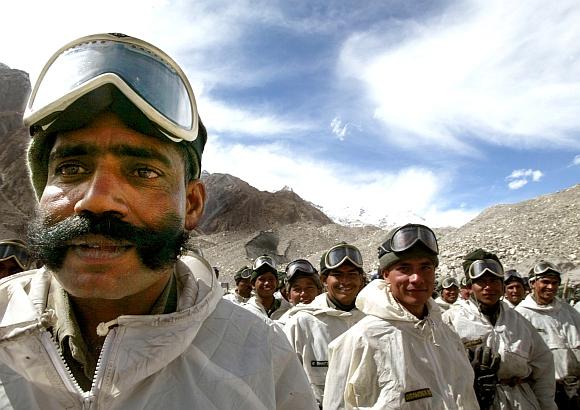
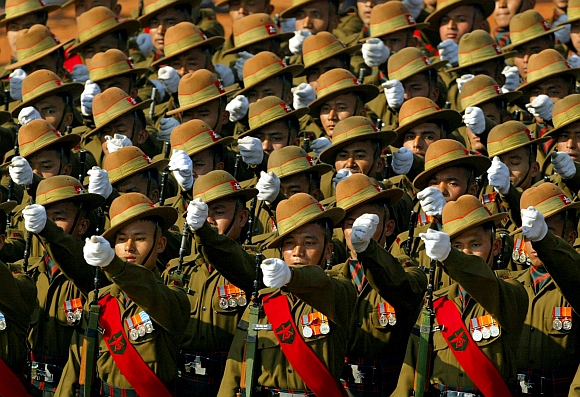

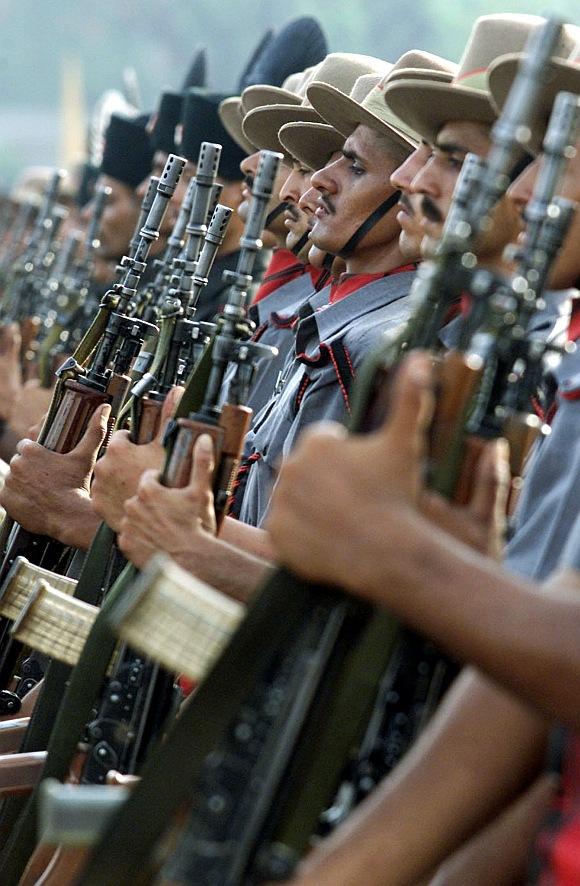
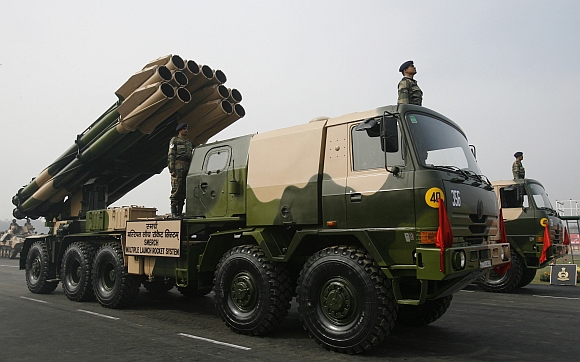
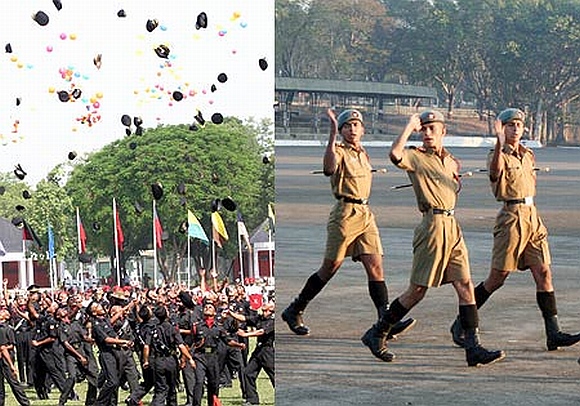
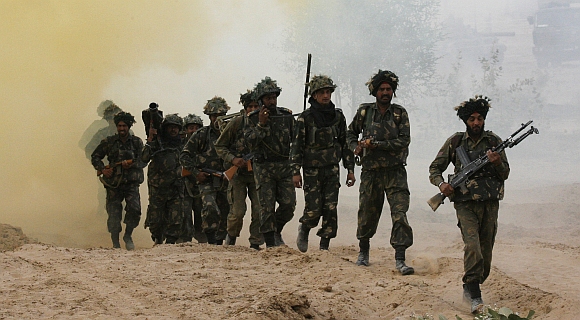
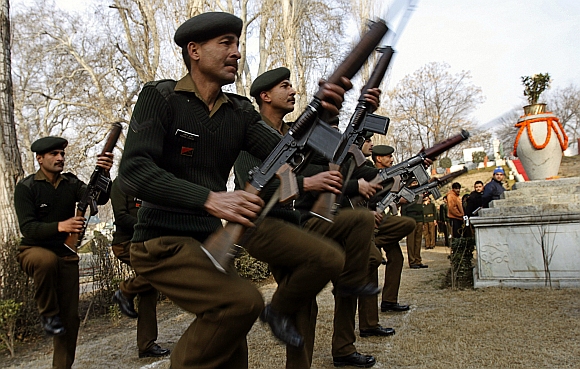


article